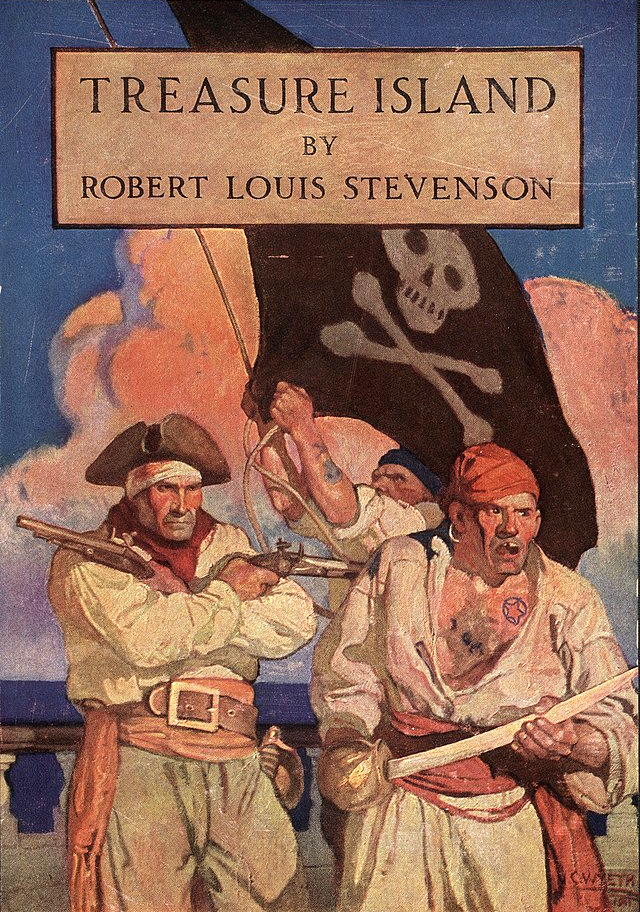Long John Silver is a fictional character and the main antagonist in the novel Treasure Island (1883) by Robert Louis Stevenson. Long John Silver is a cunning and opportunistic pirate who was quartermaster under the notorious Captain Flint. Stevenson’s portrayal of Silver has greatly influenced the modern iconography of the pirate. Long John Silver has a parrot, named Captain Flint in honor—or mockery—of his former captain, who generally perches on Silver’s shoulder, and is known to chatter pirate or seafaring phrases like “Pieces of Eight”, and “Stand by to go about.” Silver uses the parrot as another means of gaining Jim’s trust, by telling the boy all manner of exciting stories about the parrot’s buccaneer history. Silver claims to have served in the Royal Navy and lost his leg under “the immortal Hawke”. He also claims to have been the only man whom Flint ever feared. Although treacherous and willing to change sides at any time to further his own interests, Silver has compensating virtues. He is wise enough to save his money, in contrast to the spendthrift ways of most of the pirates. He is physically courageous despite his disability: for instance, when Flint’s cache is found to be empty, he coolly stands his ground against five murderous seamen despite having only Jim, a boy in his teens, to back him. Silver is married to a woman of African descent, whom he trusts to manage his business affairs in his absence and to liquidate his Bristol assets when his actions make it impossible for him to go home. He confides in his fellow pirates that he and his wife plan to rendezvous after the voyage to Skeleton Island is complete and Flint’s treasure is recovered, at which point Silver will retire to a life of luxury. According to Stevenson’s letters, the idea for the character of Long John Silver was inspired by his real-life friend William Henley, a writer and editor. Stevenson’s stepson, Lloyd Osbourne, described Henley as “…a great, glowing, massive-shouldered fellow with a big red beard and a crutch; jovial, astoundingly clever, and with a laugh that rolled like music; he had an unimaginable fire and vitality; he swept one off one’s feet”. In a letter to Henley after the publication of Treasure Island, Stevenson wrote: “I will now make a confession. It was the sight of your maimed strength and masterfulness that begot Long John Silver…the idea of the maimed man, ruling and dreaded by the sound, was entirely taken from you”.
| Alias Long John Silver |
| Real Names/Alt Names John Silver |
| Characteristics Villain, Pirate, Swashbuckler, Literary Characters, Wold Newton Universe, Realism and Victorian Age, British |
| Creators/Key Contributors N. C. Wyeth, Robert Louis Stevenson |
| First Appearance “Treasure Island or, the mutiny of the Hispaniola” in Young Folks Magazine (1881-1882) |
| First Publisher Cassell & Company |
| Appearance List “Treasure Island or, the mutiny of the Hispaniola” in Young Folks Magazine (1881-1882). Novel: Treasure Island (1883). Film: Treasure Island (1920), Treasure Island (1934), Treasure Island (1950), Long John Silver (1954). |
| Sample Read Treasure Island [PG] |
| Description Long John Silver is a fictional character and the main antagonist in the novel Treasure Island (1883) by Robert Louis Stevenson. Long John Silver is a cunning and opportunistic pirate who was quartermaster under the notorious Captain Flint. Stevenson’s portrayal of Silver has greatly influenced the modern iconography of the pirate. Long John Silver has a parrot, named Captain Flint in honor—or mockery—of his former captain, who generally perches on Silver’s shoulder, and is known to chatter pirate or seafaring phrases like “Pieces of Eight”, and “Stand by to go about.” Silver uses the parrot as another means of gaining Jim’s trust, by telling the boy all manner of exciting stories about the parrot’s buccaneer history. Silver claims to have served in the Royal Navy and lost his leg under “the immortal Hawke”. He also claims to have been the only man whom Flint ever feared. Although treacherous and willing to change sides at any time to further his own interests, Silver has compensating virtues. He is wise enough to save his money, in contrast to the spendthrift ways of most of the pirates. He is physically courageous despite his disability: for instance, when Flint’s cache is found to be empty, he coolly stands his ground against five murderous seamen despite having only Jim, a boy in his teens, to back him. Silver is married to a woman of African descent, whom he trusts to manage his business affairs in his absence and to liquidate his Bristol assets when his actions make it impossible for him to go home. He confides in his fellow pirates that he and his wife plan to rendezvous after the voyage to Skeleton Island is complete and Flint’s treasure is recovered, at which point Silver will retire to a life of luxury. According to Stevenson’s letters, the idea for the character of Long John Silver was inspired by his real-life friend William Henley, a writer and editor. Stevenson’s stepson, Lloyd Osbourne, described Henley as “…a great, glowing, massive-shouldered fellow with a big red beard and a crutch; jovial, astoundingly clever, and with a laugh that rolled like music; he had an unimaginable fire and vitality; he swept one off one’s feet”. In a letter to Henley after the publication of Treasure Island, Stevenson wrote: “I will now make a confession. It was the sight of your maimed strength and masterfulness that begot Long John Silver…the idea of the maimed man, ruling and dreaded by the sound, was entirely taken from you”. |
| Source Long John Silver – Wikipedia |

